J. Gary Polhill, Edoardo Pignotti, Nicholas M. Gotts, Pete Edwards and Alun Preece (2007)
A Semantic Grid Service for Experimentation with an Agent-Based Model of Land-Use Change
Journal of Artificial Societies and Social Simulation
vol. 10, no. 2, 2
<https://www.jasss.org/10/2/2.html>
For information about citing this article, click here
Received: 01-Sep-2006 Accepted: 20-Nov-2006 Published: 31-Mar-2007
 Abstract
Abstract
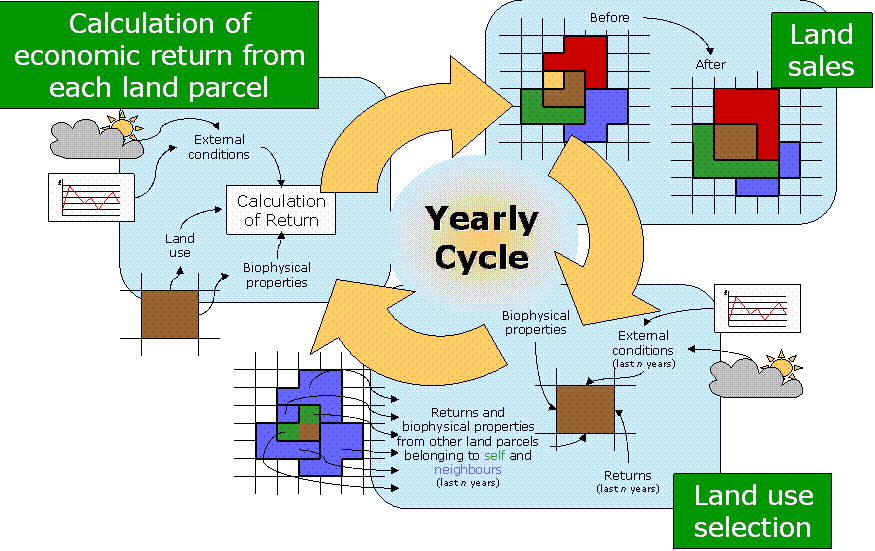
|
| Figure 1. The FEARLUS model |
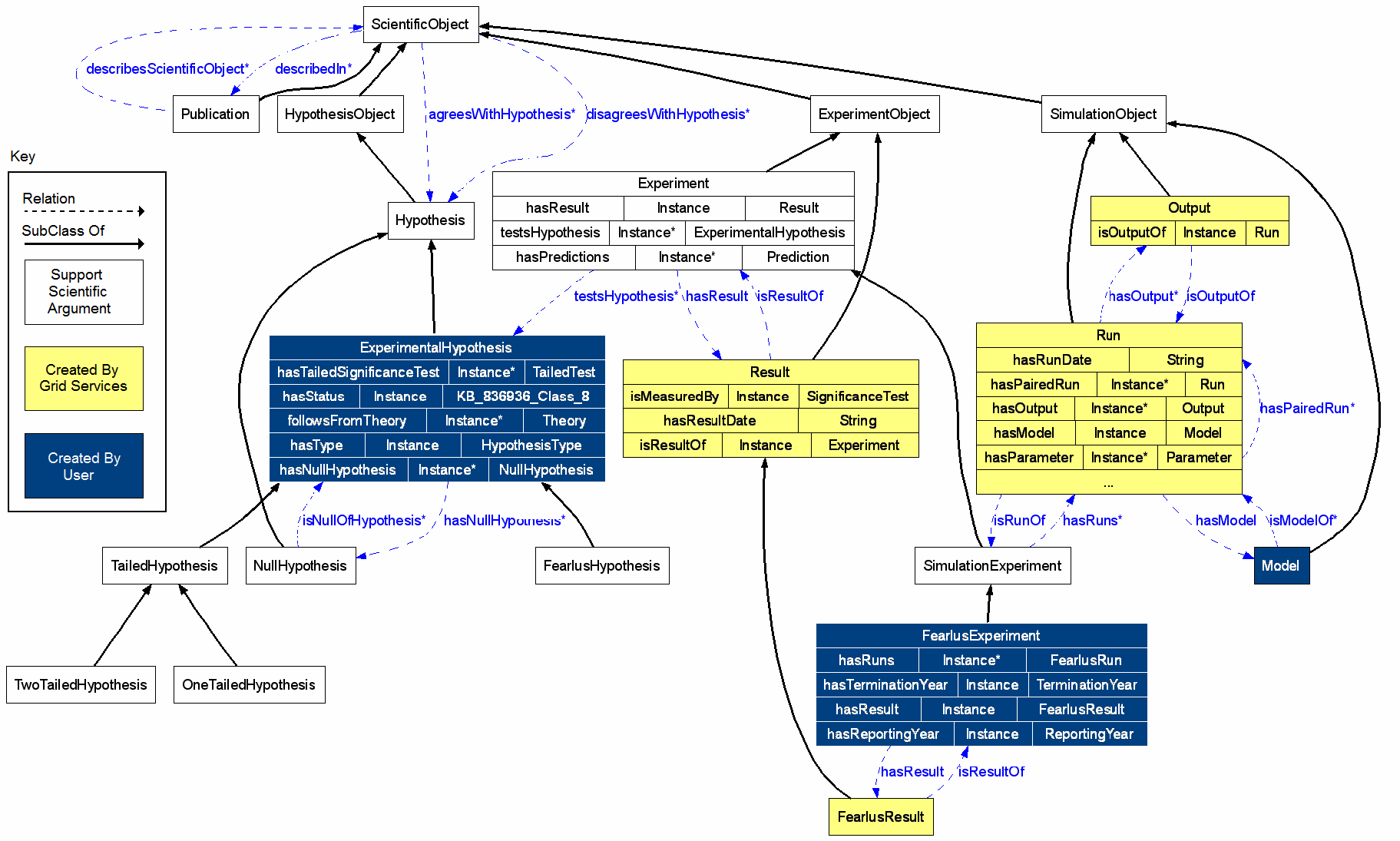
|
| Figure 2. The FEARLUS-G experimentation ontology. (© 2005 IEEE; Reproduced from Pignotti et al. (2005a) with permission.) |
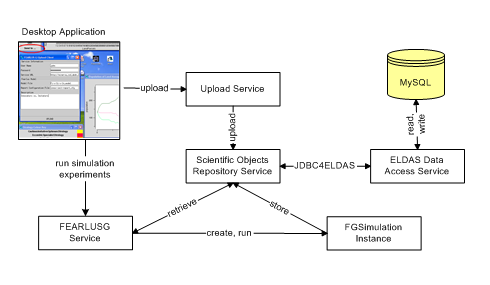
|
| Figure 3. The FEARLUS-G service architecture |
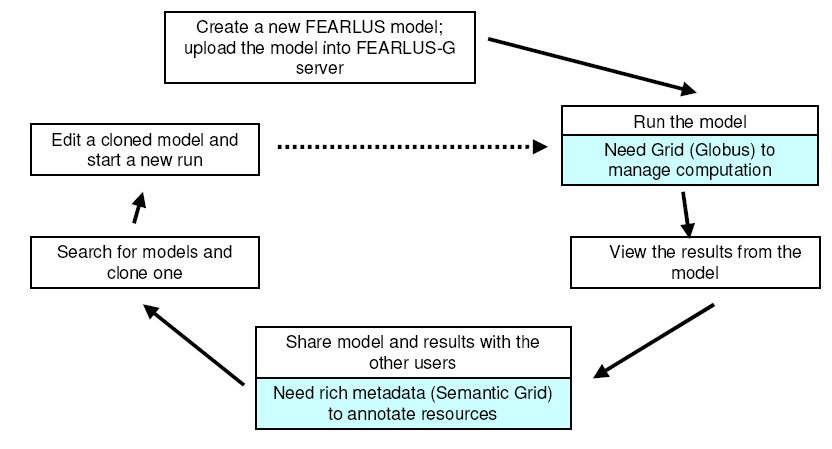
|
| Figure 4. The FEARLUS-G workflow and (in blue) the facilities provided by the Semantic Grid. (© 2005 IEEE; Reproduced from Pignotti et al. (2005a) with permission.) |
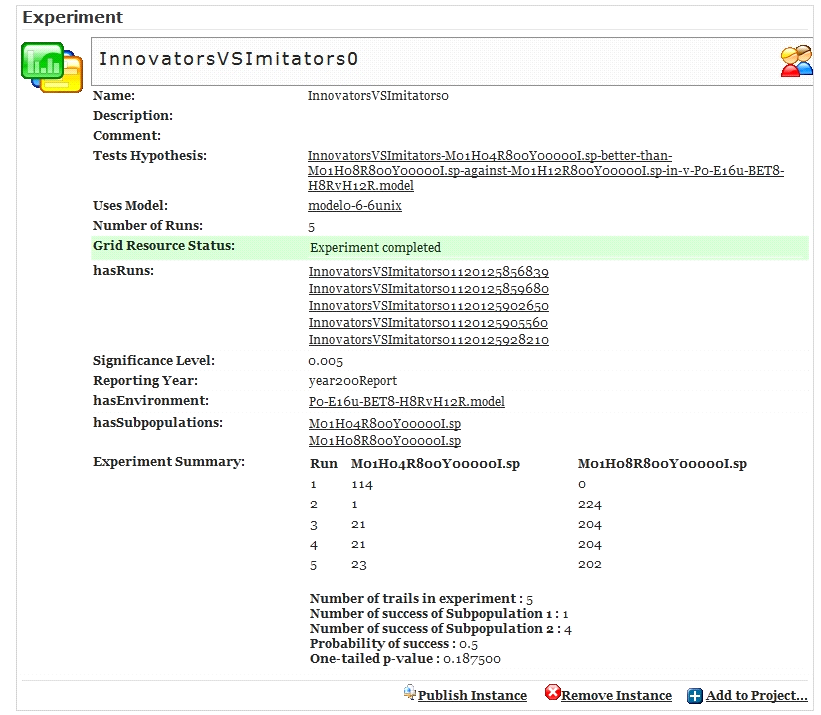
|
| Figure 5. Browsing a completed experiment |
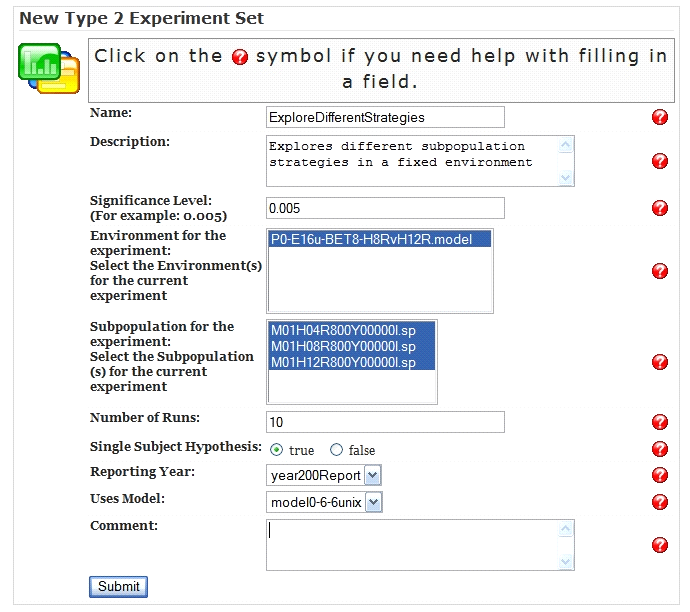
|
| Figure 6. Creating a new experiment to run |

|
| Figure 7. Editing a parameter file |
Not all categories of users require access to the same meta-data. For example, we have exposed FEARLUS model parameters to land-use scientists familiar with the existing FEARLUS application in such a way that the complexity of the Grid services is hidden to them. For this reason we provide, together with the desktop application, a web application (My Workspace) which allows users to access and manipulate low-level simulation model parameters needed to run a FEARLUS experiment. However, we also need to provide high-level data to promote accessibility to the wider scientific community. For this reason we also provide access to our public interface where resources contain high-level generic properties (e.g. describedIn, agreesWithHypothesis, hasDescription).
2 RDF stands for Resource Description Framework. See http://www.w3.org/RDF/
4 http://protege.stanford.edu/
6 The next deployed version of the system is expected to use Globus Toolkit 4.
7 http://www-unix.globus.org/toolkit/docs/3.2/security.html
ALLEN M (1999) Do it yourself climate prediction. Nature 401, p. 642.
ALLEN M, Stott P, Mitchell J, Schnur R and Delworth T (2000) Quantifying the uncertainty in forecasts of anthropogenic climate change. Nature 407, pp. 617-620.
AMERICAN HERITAGE DICTIONARIES (2004) (Eds.) The American Heritage Stedman's Medical Dictionary 2nd edition. Boston, MA: Houghton Mifflin.
BAXTER R, Ecklund D, Fleming A, Gray A, Hilld B, Rutherford S and Virdee D (2003) Designing for broadly available grid data access services. In: UK e-Science All Hands Meeting (CD-ROM).
BERNERS-LEE T, Hendler J and Lassila O (2001) The semantic web. Scientific American 284, pp. 28-37.
CORTESE P, (and several hundred others!) (2004) ALICE: Physics performance report, volume I. Journal of Physics G: Nuclear and Particle Physics 30 (11), pp. 1517-1763
EDWARDS P, Preece A, Pignotti E, Polhill G and Gotts N. (2005) Lessons learnt from the deployment of a social simulation tool to the semantic grid. Proceedings of the First International Conference on eSocial Science, NCESS/ESRC, Manchester.
FENSEL D (2003) Ontologies: A Silver Bullet for Knowledge Management and Electronic Commerce. New York: Springer-Verlag.
FOSTER I and Kesselman C (1998) "Globus: A toolkit-based grid architecture." In: The Grid: Blueprint for a Future Computing Infrastructure. Morgan-Kaufmann. pp. 259-278
FOSTER I, Kesselman C and Tuecke S (2001) The anatomy of the Grid: Enabling scalable virtual organizations. International Journal of High Performance Computing Applications 15 (3), pp. 200-222.
GILBERT N (2004) Plenary presentation to European Social Simulation Association, 2nd Annual Conference, Valladolid, Spain.
GOTTS N M and Polhill J G (2006) Narrative scenarios, mediating formalisms, and the agent-based simulation of land use change. EPOS 2006 Epistemological Perspectives on Simulation, University of Brescia, Italy, October 5-6, 2006. http://www.eco.unibs.it/epos/Papers/GottsPolhillEPOS2006Abstract.pdf
GOTTS N M, Polhill J G, and Law A N R (2003) Aspiration levels in a land-use simulation. Cybernetics and Systems 34 (8), pp. 663-683.
GRUBER T R (1993) A translation approach to portable ontology specifications. Knowledge Acquisition, 5, pp. 199-220.
IZQUIERDO L R and Galan J M (2004) Appearances can be deceiving: lessons learned reimplementing Axelrod's 'evolutionary approach to norms'. European Social Simulation Association, 2nd Annual Conference, Valladolid, Spain. http://www.uni-koblenz.de/~essa/ESSA2004/files/papers/Izquierdo_Galan_ESSA04.pdf.
LEE S, Cho M K, Jung J W, Kim J H and Lee W (2004) Exploring protein fold space by secondary structure prediction using data distribution method on Grid platform. Bioinformatics 20 (18), pp. 3500-3507
MCBRIDE B (2001) Jena: Implementing the RDF model and syntax specification. In Decker S, Fensel D, Sheth A and Staab S (eds.) Proceedings of the 2nd International Workshop on the Semantic Web (SemWeb'2001), Hong Kong, China, May 1, 2001. CEUR-WS Vol-40. http://sunsite.informatik.rwth-aachen.de/Publications/CEUR-WS/Vol-40/mcbride.pdf
MCCLELLAND J L, Rumelhart D E and The PDP Research Group (1986) Parallel Distributed Processing: Explorations in the Microstructure of Cognition. Volume 2: Psychological and Biological Models. Cambridge, MA: MIT Press.
MOSS S (2004) Search for good science: A personal memoir. New School Economic Review 1 (1), pp. 1-10. http://www.newschool.edu/gf/nser/articles/0101_mosss_goodscience_fall04_final.pdf
MOSS S and Edmonds B (2004) Towards good social science. CPM Report 04-135, Centre for Policy Modelling, Manchester Metropolitan University, UK. http://cfpm.org/cpmrep135.html
PIGNOTTI E, Edwards P, Preece A, Polhill G and Gotts N (2005a) Semantic support for computational land-use modelling. Cluster Computing and Grid 2005, Cardiff, UK.
PIGNOTTI E, Edwards P, Preece A, Polhill G and Gotts N (2005b) Providing ontology support for social simulation. Proceedings of the First International Conference on eSocial Science, NCeSS/ESRC, Manchester.
POLHILL J G and Gotts N M (2006) A new approach to modelling frameworks. Proceedings of the First World Congress on Social Simulation, August 21-25 2006, Kyoto University, Kyoto, Japan. Vol. 1, pp. 119-126.
POLHILL J G, Gotts N M and Law A N R (2001) Imitative versus nonimitative strategies in a land use simulation. Cybernetics and Systems 32 (1-2), pp. 285-307.
POLHILL J G, Izquierdo L R and Gotts N M (2005) The ghost in the model (and other effects of floating point arithmetic). Journal of Artificial Societies and Social Simulation 8 (5) https://www.jasss.org/8/1/5.html
POLHILL J G, Izquierdo L R and Gotts N M (2006) What every agent based modeller should know about floating point arithmetic. Environmental Modelling and Software 21, pp. 283-309.
POLHILL J G, Pignotti E, Gotts N M, Edwards P and Preece A. (2005) "An ontology for experimentation with a social simulation of land use change". In Troitzsch K (Ed.) Representing Social Reality: Pre-Proceedings of the Third Conference of the European Social Simulation Association, Koblenz, , 5-9 September 2005. Germany: Verlag Dietmar Fölbach, pp. 324-330
RAO A S and Georgeff M P (1991) "Modeling rational agents within a BDI-architecture." In Allen J, Fikes R and Sandewall E (Eds.) Proceedings of the Second International Conference on Principles of Knowledge Representation and Reasoning. San Mateo, CA: Morgan Kaufmann Publishers.
DE ROURE D, Jennings N and Shadbolt N (2001) Research agenda for the semantic grid: A future e-science infrastructure. Technical Report, UK e-Science Series UKeS-2002-02, National e-Science Centre, Edinburgh, UK.
SEIGEL S and Castellan N J (1988) Nonparametric statistics for the behavioural sciences: International edition. Statistics Series, 2nd ed. Singapore: McGraw-Hill.
YANG X J, Chang Z M, Zhou H F, Qu X L and Li C J (2004) "Services for parallel remote-sensing image processing based on computational grid". Proceedings of the Grid and Cooperative Computing Workshops 2004, Lecture Notes in Computer Science 3252, pp. 689-696.
Return to Contents of this issue
© Copyright Journal of Artificial Societies and Social Simulation, [2007]